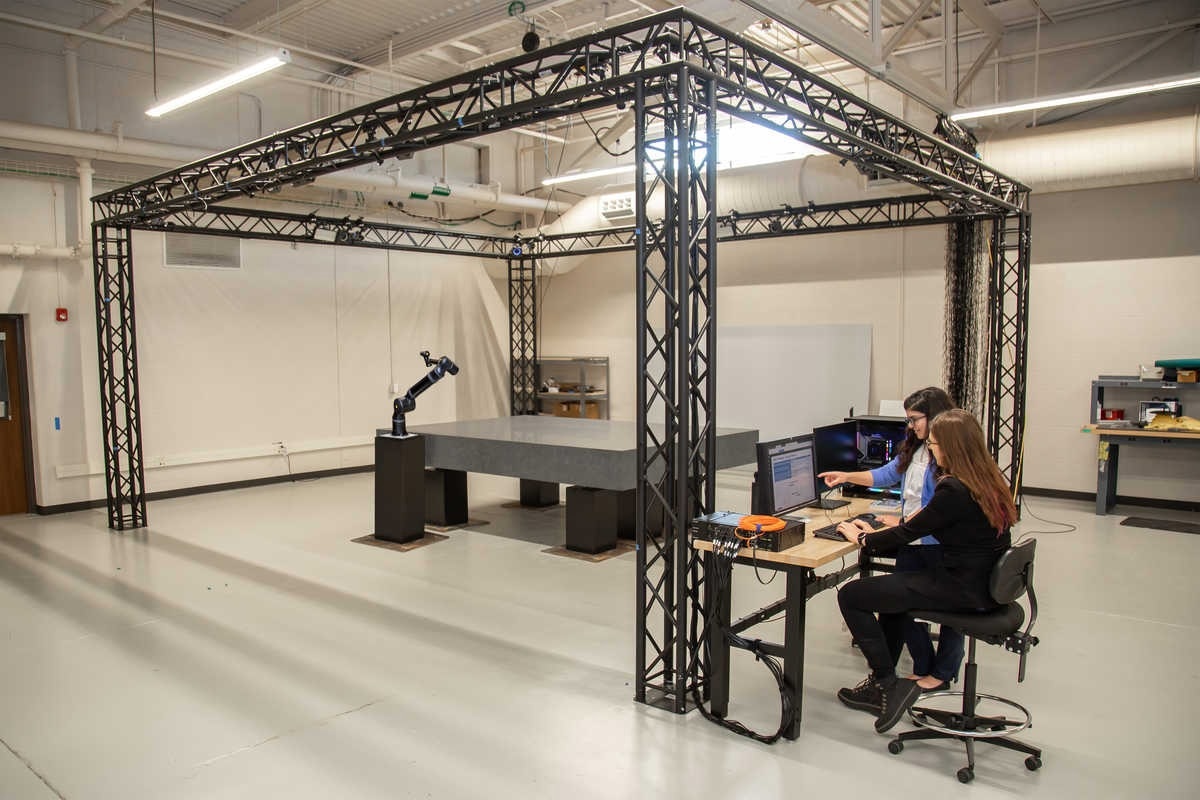Reviewed by Lexie CornerApr 10 2024
Southwest Research Institute has invested in novel space robotics capabilities to help the space sector prepare for in-space assembly, manufacturing, and maintenance (ISAM) capabilities. At the 38th Space Symposium in Colorado Springs, which takes place from April 8 to 11, SwRI’s Intelligent Systems Division will showcase its latest research on ISAM. SwRI is located at Booth #237.
 SwRI’s Space Robotics Center features an air-bearing table to simulate low-gravity conditions, allowing engineers to test robot applications for future deployment in zero gravity. Image Credit: SPACE ROBOTICS CENTER
SwRI’s Space Robotics Center features an air-bearing table to simulate low-gravity conditions, allowing engineers to test robot applications for future deployment in zero gravity. Image Credit: SPACE ROBOTICS CENTER
SwRI is developing solutions to leverage Earth-based industrial robotics with advanced automation and simulation so we can help clients develop new capabilities for the complex conditions of space.
Meera Towler, Senior Research Engineer, Southwest Research Institute
The Space Symposium brings together global leaders to discuss and prepare for the future of space. NASA and others foresee a space industry with agile vehicles that can deploy materials and parts into space for robotic manufacturing and assembly. Developing Earth- and lunar-based test beds, as well as research facilities on the Moon’s surface, is a crucial step toward ISAM’s realization.
SwRI’s space robotics research is focused on high-fidelity simulation, improved perception, extraterrestrial automated driving, and robotic manipulation in space. This research is supported by SwRI’s new Space Robotics Center, which includes an air-bearing table, a seven-degree-of-freedom robot arm, a motion capture system, test fixtures, and other equipment.
Engineers created software and modeling tools to assist robots in planning movements under complicated, on-orbit settings. SwRI is also working on efficient low-power vision for lunar rovers and small aerial systems.
We are excited to share these R&D projects with the space community to help bridge the gap between today’s power-hungry, Earth-based industrial robots and the near-future ISAM ecosystem, where advanced automation will help build the next generation of space infrastructure.
DrSteve Dellenback, Vice President, Intelligent Systems Division, Southwest Research Institute
- Space-Based Robot Motion Planning- SwRI created a robotics simulation package using a physics-based modeling tool to handle difficulties such as object recognition, trajectory tracking, and dynamic motion planning in space. SwRI will test the simulation models using a robot arm on an air-bearing table at the Space Robotics Center
- Localization for Lunar Rovers- SwRI studied using its Ranger localization system on lunar rovers. Ranger’s ground-facing cameras and automation software successfully steered a rover across a simulated regolith
- Camera Vision for Cave Exploration- SwRI used caves as test beds to assess unoperated aerial systems (UAS) for potential space applications. New algorithms employed stereo cameras to guide a small UAS autonomously
- Stereovision vs. Lidar for Off-Road Autonomy- SwRI employed a recurrent neural network (RNN) algorithm to calculate vehicle motion from a series of camera images, inertial measurements, and wheel data for off-road navigation. Stereovision, an alternative to lidar, might enable simultaneous localization and mapping for extraterrestrial navigation
- FPGA Computing for Faster Object Detection- SwRI employed a space-ready field programmable gate array (FPGA) to speed up object detection. The approach used an open-source algorithm deployed on an FPGA, which outperformed a commercially available solution and conventional space computers
- RISC-V/ARM for Faster Space Computing- SwRI is testing the next generation of fast, dependable microprocessors for embedded spaceflight systems. Some space-ready FPGAs outperformed traditional processors, and an Advanced RISC Machines (ARM) processor outperformed a legacy space processor while consuming a fraction of the energy
The Intelligent Systems Division of SwRI is a pioneer in the development of systems engineering, software, cybersecurity, and artificial intelligence solutions.